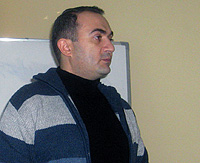 Tevan Pogosyan is the first expert and trainer on effective communication, negotiation and conflict management skills. He opened series of
Tevan Pogosyan is the first expert and trainer on effective communication, negotiation and conflict management skills. He opened series of
peacemaking trainings conducted by School for participants from Kyrgyzstan and Uzbekistan in 2010.
His training skills are certified in the Kennedy School of Government, Harvard University of the USA, Conflict Management Group in Cambridge in the USA, and his techniques on the destruction of stereotypes and the elements of the effective negotiations are being used by activists and journalists in Kyrgyzstan so far. His methods of teaching at the mediation were successfully tested in the post-conflict period in Armenian and Azerbaijani communities. Tevan is also executive director of the International Center for Human Development in Armenia, included in the list of the top 25 brain trust centers of the countries of Central and Eastern Europe. At the end of the nineties, Pogosyan was the representative of the Nagorno-Karabakh Republic in the USA, and in 2012 he became a member of the National Parliament of Armenia.
 Vyacheslav Likhachev is an expert in the area of the ethno-political conflict solving, xenophobia on the post-Soviet spacepolitical extremism, the theory of nation and nationalism. He joined the team of experts of the School of Peacemaking and Media Technology in 2012. Vyacheslav deals with developing of training methodologies on media monitoring tools to identify the hate speech and conflict-prone attitudes for School, and conducts webinars on the ways of avoiding hate speech in public discourse.
Vyacheslav Likhachev is an expert in the area of the ethno-political conflict solving, xenophobia on the post-Soviet spacepolitical extremism, the theory of nation and nationalism. He joined the team of experts of the School of Peacemaking and Media Technology in 2012. Vyacheslav deals with developing of training methodologies on media monitoring tools to identify the hate speech and conflict-prone attitudes for School, and conducts webinars on the ways of avoiding hate speech in public discourse.
Likhachev also runs a program for monitoring and analysis of xenophobia Congress of National Communities of Ukraine, is the author of several books, 300 articles and more than 60 scientific publications.
The analytical review "Hate Speech and Ethnical Stereotypes in Print Media in Southern Kyrgyzstan", which is a summary report of the Media Monitoring Group for School of Peacemaking and Media Technologies on the results of several studies of media in 2010, 2011 and 2012, is prepared. During this period the group, which included professional journalists and media experts, conducted a study on the subject of identifying ethnical stereotypes, hate speech, and content analysis of publications on contentious.
Analytical review is based on a study of the content of articles in Kyrgyz-language, Uzbek-language and Russian-language press and random express surveys with a population and the media community of Osh, Jalalabad and Batken regions of southern Kyrgyzstan. The examples given in the report are accompanied by the originals scanned from newspaper articles.
The work is not aimed at the production of some recommendations, since the main objective of this study was the creation of an analytical framework for the development of training materials on peace journalism for training workshops conducted by Schools of Peacemaking for reporters in southern Kyrgyzstan and the Fergana Valley.
This report can be useful to researchers, human rights activists and journalists.(See here the full report >>)
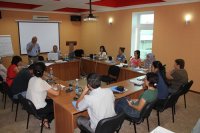 School of Peacemaking and Media Technology is a nonprofit media
development organization focusing on peace research, advocacy, and training on
media issues. Organization vision statement aims at supporting freedom of
expression, access to information and citizens making informed opinions and
decisions as a means of promoting an informed, democratic and tolerant
society. We as well promote free and
fair journalism in areas of crises and conflicts in Kyrgyzstan and the Central
Asian Region.
School of Peacemaking and Media Technology is a nonprofit media
development organization focusing on peace research, advocacy, and training on
media issues. Organization vision statement aims at supporting freedom of
expression, access to information and citizens making informed opinions and
decisions as a means of promoting an informed, democratic and tolerant
society. We as well promote free and
fair journalism in areas of crises and conflicts in Kyrgyzstan and the Central
Asian Region.
Our organization was established in June 2010 after ethnic violence in the southern Kyrgyzstan for mediation and peacemaking training and capacity building of the local community in the post-conflict period. School of Peacemaking was registered as a Network of Social Mediators Public Foundation.
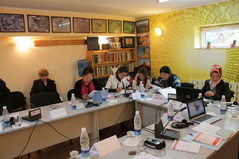 On October 24-25-26-27, 2013 a training on peacemaking journalism, conflict reporting and the destruction of stereotypes for print and online media in Osh, Jalalabad and Batken oblasts of Kyrgyzstan was organized by the School of Peacemaking and Media Technology of Network of Social Mediators public foundation.
On October 24-25-26-27, 2013 a training on peacemaking journalism, conflict reporting and the destruction of stereotypes for print and online media in Osh, Jalalabad and Batken oblasts of Kyrgyzstan was organized by the School of Peacemaking and Media Technology of Network of Social Mediators public foundation.
The aim of the event was to teach reporters to media tools for reducing the charge to a confrontational society, techniques destabilizing confrontation, the organization of post-conflict rehabilitation of journalists, and ways to find common mechanisms to improve the efficiency of media peacemaking efforts.
The training was held in the form of an interactive discussion. Reporters learned the theory of reporting on conflicts and consolidated their knowledge by participating in an interactive game, prepared by experienced trainers Arif Aliyev (Azerbaijan) and Ashot Melikyan (Armenia).
Training participants also used their knowledge for practical exercises to overcome xenophobic stereotypes, working with publications of local journalists containing hate speech.
With the help of the trainers journalists have developed a glossary of stereotypes, which must become a handbook for journalists working in conflict zones.
"I acquired a lot of useful knowledge in the training. Now I know how to cover conflicts correctly," a training member Apihazan Amitova, correspondent of the Osh Shamy newspaper said.
There are a lot of problems mecessary to report on in our region, however, it is dangerous to cover these problems in media. The training has taught us to conflict reporting technologies and post-conflict rehabilitation of the journalist, Alina Sydykova, correspondent of Oshmedia site said.
Today, the School of Peacemaking and Media Technologies has been trained about 80 journalists from media outlets in southern Kyrgyzstan. The training was conducted by specially developed techniques, which are based on practical experience of building media dialogue in conflict-prone areas of the world: the Balkans and the Caucasus. Within the School webinars on destroying stereotypes, clichés, and overcoming the image of the enemy in mass media are conducted.
The training is organized to promote peacemaking journalism, the ability of journalists to discuss openly issues of conflict, training of finding the common ground between the opposite sides of the conflict, and techniques of finding active groups from different communities who are ready for dialogue, analysis of existing patterns of conflicts and methods of their destruction.
The four-day training seminar for journalists in southern Kyrgyzstan is led by an experienced team of media experts with extensive practical experience in building a media dialogue in conflict areas of the world: in the Balkans and the southern Caucasus.
The event will be held in the form of interactive discussion, the combination of theory and practice.
The training will be held in Bishkek, date on October 24, 25, 26, 27 (arrival on October 23, exit on October 28) 2013. All expenses are paid by the organizers.
To participate in the seminar, it is necessary to fill out an electronic form on the site www.ca-mediators.net or to send your resume and motivational letter by October 10, 2013. In motivational letter you should indicate why you would like to participate in this training, and how it will affect the future of your career. Also, e-mail to thepeacemakingschool@gmail.com a scanned copy of your passport.
The bids are considered only if there is a complete set.
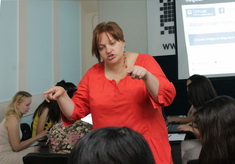 Leading trainer in multimedia report production at the Camp for Media Innovations Oksana Silantieva recommends the following: first of all, it is important to start mastering skills of photo and video shooting using simple equipment, creating infographics on available free websites and combine everything together. Multimedia journalist is a balance between the meaning and the form, she says.
Leading trainer in multimedia report production at the Camp for Media Innovations Oksana Silantieva recommends the following: first of all, it is important to start mastering skills of photo and video shooting using simple equipment, creating infographics on available free websites and combine everything together. Multimedia journalist is a balance between the meaning and the form, she says.
Multimedia journalism is a craft. As any other craft, this profession is based on basic principles and skills. Multimedia journalist can write decently, shoot decently, make photos and create infographics decently.
If you wrote only in newspapers earlier, then you will have to learn how to make photos, study what composition and color are at a basic level, rather than at the professional photographer’s level. This is needed to make photos with correct composition, and that are meaningful. Such basic things are offered by distance courses. Now a lot of manuals can be found on the internet – go for it! Further on you will have to practice only.
As soon as you master photography, you can start video shooting. What is the difference between the photo and the video, what is editing, what views can be or cannot be edited? Just find the Principles of video editing on the internet, read them, and start shooting video. There’s no need to have classical big cameras.
Don’t try to master some extra professional equipment under any circumstance! Leave it to broadcasters. A smartphone is enough to take a nice shot that can be posted on the web. A multimedia journalist is known not for techniques (though, he can have them), but for the skill of combining them.
A multimedia journalist is a reporter obsessed with the stories. When he sees the issue, he sees what event it can be. He looks at the event and starts gathering information just like any traditional journalist does. But he structures the story in the multimedia format in his head, “So many people have gathered here! I can make a 360 degree panoramic shot to demonstrate the event vividly.”
Or, for example, the event is full of movement. People are running, bicyclers are cycling, something is falling down, someone is shouting. This movement is better demonstrated by a video. A multimedia journalist reacts promptly to that: he takes out his smartphone and records a video, collects people’s quotes, runs to the office (or uses his notebook on the spot), assembles the story out of small parts, adds some text, some photos, some infographics. Present technology helps people not master highly professional applications, but mastering figures and meaning is a must.
When you take a course in a multimedia journalism, you should not forget about traditional journalism, which implies the search and check of information, search for heroes, their development by asking correct questions, comparison of figures and data check. No technology can replace this.
To become a multimedia journalist, one should practice a lot. No university or lecture can replace daily hours-long practice. Only practice can lead to the craft of multimedia journalism. Don’t be afraid to make mistakes, to make it better and to get satisfaction from it!
 The Camp for Media Innovations has not only given journalists from print and online media outlets of the Kyrgyz Republic an opportunity to raise their professional skills, but has also granted a chance to participate in the contest for a potentially best multimedia project.
The Camp for Media Innovations has not only given journalists from print and online media outlets of the Kyrgyz Republic an opportunity to raise their professional skills, but has also granted a chance to participate in the contest for a potentially best multimedia project.
From July 24 to July 29, 2013, 19 journalists had a chance to attend an intensive training course that focused on teaching for contemporary methods of constructing multimedia mosaic, photo, video and infographic elements, designing multimedia scenarios, constructing basic websites and promoting content online. Participants learned media management techniques and practiced in writing unbiased articles for multi-ethnic audiences.
Classes were carried out in a very interactive mode. The theory was immediately applied into practice. During sessions, the participants learned creating websites, online databases and check-lists. They practiced posting interactive photos on their websites and bring visual elements together into a single multimedia history.
“I particularly want to highlight journalists’ genuine interest to study new media instruments, - says the trainer from Moscow Oksana Silantieva, - We managed to learn six highly difficult multimedia services in one day and the group kept this wild rhythm during this whole time! I was extremely impressed!”
The trainer from Almaty Gulim Amirkhanova taught the Camp participants for key techniques of social network marketing and media planning.
“Before this training I had no idea that our website has actually these many drawbacks, - says Mirbek Asanaliev, the editor-in-chief of the information portal ‘Jumgal KG’.– Now, thanks to the Camp for Media Innovations, I am ready to work upon them”.
During the last day of training, the journalists wrote applications, where they proposed interesting multimedia ideas for social projects and technical modernization of their editors offices.
After three-hour discussion, an independent selection board composed of external media experts selected seven winners and handed certificates for technical assistance.
The following media outlets proposed best project ideas:
“Aymak” from Jalal-Abad (“Project on Improving Interethnic Relations”),
“Miner’s Path” («Путьшахтера») from Sulukta city (“Developing Information Awareness of the Local Population via Different Means of Communication”),
“Financier” («Финансист») from Bishkek city (“Widening Access to Economic Information through Creating Interactive Online Platform”),
“SuLei-Info” from Isfana in the Leilek region of Batken oblast (“Solving Social Problems of the Local Population through Distribution of Information and Integration”),
“Danek” from Osh city (“Training Young Multimedia Journalists and Promoting Content”),
Website “Jumgal KG” («Жумгал KG») from Chayek village of the Naryn oblast (“Tackling Hunger for Information Problem in the Region”),
Information Agency “AKIpress-Osh” (Youth Media Initiatives for Helping the Population).
During August all the winners will receive requested equipment (computers, smartphones, dictaphones) and will have their expenses covered for the Internet connection, hosting and web-design.
“Victory (in the contest) has given me confidence, but it is also a huge responsibility”, - says the editor-in-chief of the newspaper “Miner’s Path” («Шахтержолу») from Sulukta in the Batken oblast Gulmira Abdunazarova. Her project was immediately selected in a solid vote. “Now we are ready to work through the new strategy for our next steps”, - she adds.
Another winner – the editor-in-chief of the newspaper “SuLei-Info” from Isfana, Abdillabek Avazov – says it was during the training that he thought of the idea to create an interactive information platform, where social problems of the local population can be solved jointly with local authorities. “Every time I think of the opportunities that we are being granted, I get emotional. I am really happy!” – exclaims Avazov.
 On the 24 of July 2013 Camp for Media Innovations of School of Peacemaking and Media Technologies starts off. 19 journalists from print media and online of the Kyrgyz Republic, who have been selected to participate in the Camp, will study contemporary methods of creating and distributing information, promoting content online, techniques of media management and writing objective articles for multi-ethnic audience.
On the 24 of July 2013 Camp for Media Innovations of School of Peacemaking and Media Technologies starts off. 19 journalists from print media and online of the Kyrgyz Republic, who have been selected to participate in the Camp, will study contemporary methods of creating and distributing information, promoting content online, techniques of media management and writing objective articles for multi-ethnic audience.
During six upcoming days, professional foreign trainers from Russia, Ukraine, Kazakhstan and Kyrgyzstan will teach the participants for the best ways of creating scenarios for multimedia publications, working with online texts, producing digital photo and video-recording from mobile phones, working with mobile applications, building inforgraphics and creating online versions of newspapers.
A separate session will be devoted to learning from the experiences of foreign online sources and getting the idea of how print media can profit from the use of multimedia. The trainings will be held in an interactive format, combining theory with practice.
“The world is becoming all about multimedia, while news is more and more mobile. Over half of print media in the Kyrgyz Republic, however, do not have online content and are falling off the current media development trend”, - says the Director of School of Peacemaking and Media Technologies, Inga Sikorskaya. “We want to help Kyrgyzstani media going up on a new level of producing contemporary content and becoming competitive in the media market. This will surely give more opportunities for the audience as well to receive quality information”, - she says.
Technical assistance will help applying the knowledge in practice. It will be later played off at the “Ideas Parade” competition during the last day of the Camp.
As a result of the contest, seven most competitive applications will be selected by a qualified panel. The media outlets, who win the competition, will receive specialized technical equipment, which is necessary for multimedia content production.
First of July 2013 was the deadline for submission of documents for Camp for Media Innovations. The call for applications, which was met with keen interest in all the regions of Kyrgyzstan, has raised 29 application packages. As a result of competitive selection stage, 19 winners have been identified. Each of them will represent home editorial office during a six-day-training taking place in Bishkek on July 24-29, 2013.
The finalists are expected to attend a multi-level training, where they will be introduced to a variety of interactive technologies, infographics, media management and the ways of promoting print content online. Additionally, they will undergo a course on ethnicity journalism and will participate in a competition-structured game “Parade of Ideas”, which will conclude with a project writing activity. The participants will apply for technical assistance that will be used to modernize the work of their editorial offices. A competent and independent commission composed of media experts will review the applications and select six-seven best candidates to receive the equipment requested.
The trainers at the Camp will be internationally approved media experts from Russia, Ukraine, Kazakhstan and Kyrgyzstan.

The School of Peacemaking and Media Technology in Central Asia announces an annual competition among students from Kyrgyzstan, Kazakhstan,…
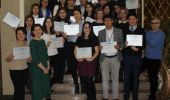
25 journalists and media workers from various regions of Kyrgyzstan have been trained to counter the propaganda of violent extremism and hate in…